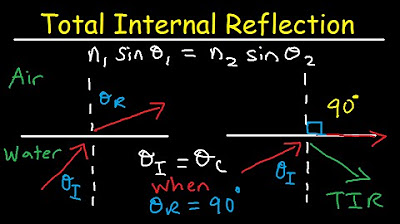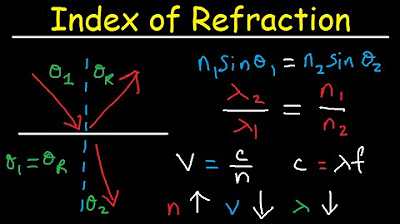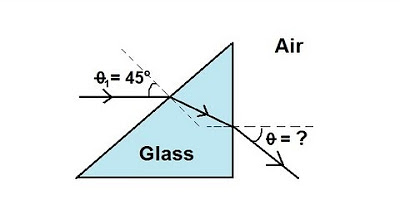Snell's Law & Index of Refraction Practice Problems - Physics
TLDRThis educational lesson explores the principles of the index of refraction and Snell's Law through various practice problems. It explains how the speed of light varies in different media, using water and diamond as examples, and demonstrates the calculation of the index of refraction and wavelength changes. The lesson also applies Snell's Law to determine the angle of refraction when light passes from air to water and from glass to diamond, highlighting the relationship between the index of refraction and the bending of light rays.
Takeaways
- 💡 The speed of light in water is slower than in a vacuum, calculated by dividing the speed of light in a vacuum by the index of refraction of water (1.33).
- 🚀 The speed of light in a vacuum is 3 x 10^8 meters per second.
- 🔍 The index of refraction of a material can be found by dividing the speed of light in a vacuum by the speed of light in that material.
- 💎 The index of refraction of diamond is approximately 2.42, derived from its speed of light (1.24 x 10^8 meters per second).
- 🌈 The wavelength of light in a material is found by dividing the wavelength of light in a vacuum by the material's index of refraction.
- 📏 The wavelength of light in glass (index of refraction 1.5) is 400 nanometers when the wavelength in a vacuum is 600 nanometers.
- 📉 As the index of refraction increases, the wavelength of light in the material decreases.
- 🔢 For a light wavelength of 450 nanometers in glass, the corresponding wavelength in diamond (index of refraction 2.42) is approximately 279 nanometers.
- ↘️ When light moves from a material with a lower index of refraction to one with a higher index, the angle of refraction decreases and light bends closer to the normal line.
- ↗️ Conversely, when light travels from a material with a higher index of refraction to one with a lower index, the angle increases and light bends away from the normal line.
- 📐 Using Snell's Law, the angle of refraction for light moving from air (n=1) to water (n=1.33) with an incidence angle of 30 degrees is 22 degrees.
- 🛠️ For a light ray passing from air into glass (n=1.5) at a 60-degree incidence, then into diamond (n=2.42), the refraction angles can be calculated step-by-step or directly using Snell's Law.
- 🔄 When light strikes a material at an angle and continues into another material, the refraction angle at each boundary can be calculated using Snell's Law and trigonometric relationships.
Q & A
What is the speed of light in a vacuum?
-The speed of light in a vacuum is 3 x 10^8 meters per second.
How do you calculate the speed of light in water?
-The speed of light in water is calculated by dividing the speed of light in a vacuum by the index of refraction of water. The formula is: speed of light in water = (speed of light in a vacuum) / (index of refraction of water).
What is the index of refraction for water?
-The index of refraction for water is 1.33.
What is the speed of light in water?
-The speed of light in water is approximately 2.256 x 10^8 meters per second.
How do you calculate the index of refraction of a material?
-The index of refraction of a material is calculated using the formula: n = c / v, where 'n' is the index of refraction, 'c' is the speed of light in a vacuum, and 'v' is the speed of light in the material.
What is the index of refraction of diamond?
-The index of refraction of diamond is approximately 2.42.
How does the index of refraction affect the speed of light in a material?
-As the index of refraction of a material increases, the speed of light in that material decreases.
What is the wavelength of light in glass if the wavelength in a vacuum is 600 nanometers?
-The wavelength of light in glass is 400 nanometers.
How does the index of refraction affect the wavelength of light in a material?
-As the index of refraction increases, the wavelength of light in that material decreases.
What is Snell's Law?
-Snell's Law states that n1 * sin(θ1) = n2 * sin(θ2), where n1 and n2 are the indices of refraction of the two media, and θ1 and θ2 are the angles of incidence and refraction, respectively.
How do you calculate the angle of refraction when light passes from air into water?
-To calculate the angle of refraction, use Snell's Law: n1 * sin(θ1) = n2 * sin(θ2). For air (n1 ≈ 1) and water (n2 = 1.33), and given an angle of incidence θ1 = 30 degrees, θ2 can be calculated as: sin(θ2) = sin(30) / 1.33. Therefore, θ2 ≈ 22 degrees.
What happens to the angle of a light ray when it travels from a low index of refraction material to a high index of refraction material?
-When light travels from a low index of refraction material to a high index of refraction material, the angle of the light ray decreases and bends closer to the normal line.
What is the angle of refraction when light enters diamond from glass with an incidence angle of 60 degrees?
-The angle of refraction when light enters diamond from glass with an incidence angle of 60 degrees is approximately 21 degrees.
What is the angle x when a light ray leaves a material with an index of refraction of 1.2 at an incident angle of 70 degrees?
-The angle x when a light ray leaves a material with an index of refraction of 1.2 at an incident angle of 70 degrees is approximately 48.3 degrees.
Outlines
🌟 Understanding the Index of Refraction and Snell's Law
This paragraph introduces the concept of the index of refraction and Snell's law through practice problems. It explains how the speed of light in a material is calculated using the formula v = c/n, where v is the speed of light in the material, c is the speed of light in a vacuum, and n is the index of refraction. The paragraph uses the example of water, where the speed of light is found to be 2.256 x 10^8 meters per second, demonstrating that light travels slower in water than in a vacuum. It further explores the index of refraction for diamond, calculating it to be approximately 2.42, and discusses the relationship between the index of refraction and the speed of light. The paragraph also covers the concept of wavelength in different materials, illustrating how the wavelength of light changes when it passes from a vacuum to glass, and then from glass to diamond, emphasizing that as the index of refraction increases, the wavelength decreases.
🔍 Calculating the Angle of Refraction Using Snell's Law
This paragraph delves into the application of Snell's law to calculate the angle of refraction of light when it passes from one medium to another. It begins by explaining how to find the angle of refraction when light travels from air to water, using the given angle of incidence and the index of refraction for both media. The paragraph shows that as the index of refraction increases, the angle of refraction decreases, moving the light ray closer to the normal line. It also discusses the reverse scenario where light travels from a high to a low index of refraction, resulting in an increase in the angle of refraction. The paragraph then extends this concept to a scenario where light travels from air to glass and then to diamond, illustrating the process of calculating the angle of refraction at each boundary and emphasizing the importance of understanding the relationship between the angles and the indices of refraction.
📐 Advanced Refraction Calculations Across Multiple Media
The third paragraph continues the discussion on refraction, focusing on more complex scenarios involving multiple media. It explains the concept that the angle of refraction at one boundary is equal to the angle of incidence at the next boundary, using diagrams to illustrate this point. The paragraph provides a step-by-step calculation for determining the angle of refraction when light travels from air to glass and then to diamond, emphasizing the importance of using Snell's law and the indices of refraction for each medium. It also introduces a shortcut method for calculating the final angle of refraction without needing to calculate intermediate angles, showing that knowing the initial angle of incidence and the indices of refraction for the initial and final media is sufficient to find the final angle.
🛠 Practical Application of Snell's Law in Refraction Problems
In the final paragraph, practical application of Snell's law is demonstrated through a problem involving a light ray striking a material with an index of refraction of 1.2 from air at an incident angle of 70 degrees. The paragraph guides through the calculation of the angle of refraction in the material and then determines the angle at which the light ray leaves the material when it returns to air. It highlights the importance of considering the change in the direction of the normal line when dealing with different media and provides a clear example of how to calculate the complementary angle to find the final angle of refraction. The paragraph concludes with the final calculated angle, demonstrating the comprehensive use of Snell's law in solving refraction problems.
Mindmap
Keywords
💡Index of Refraction
💡Speed of Light
💡Snell's Law
💡Wavelength
💡Vacuum
💡Angle of Incidence
💡Angle of Refraction
💡Normal Line
💡Optics
💡Light Ray
Highlights
The speed of light in water is calculated using the formula v = c / n, where c is the speed of light in a vacuum and n is the index of refraction.
The index of refraction for water is 1.33, resulting in a reduced speed of light in water compared to a vacuum.
As the index of refraction of a material increases, the speed of light in that material decreases.
The index of refraction of diamond is calculated to be approximately 2.42 using Snell's Law.
The wavelength of light in a material is determined by dividing the wavelength in a vacuum by the material's index of refraction.
The wavelength of light in glass is shorter than in a vacuum due to its higher index of refraction.
The relationship between the indices of refraction of two materials can be used to find the wavelength of light in one material given the other.
The wavelength in diamond is shorter than in glass due to its higher index of refraction.
Snell's Law is used to calculate the angle of refraction when light passes from one medium to another.
Light bends towards the normal line when moving from a lower to a higher index of refraction material.
The angle of incidence equals the angle of refraction when light passes from one medium to another with a continuous path.
A shortcut for calculating the angle of refraction in multiple media is to use the initial angle of incidence and the indices of refraction of the first and last media.
When light travels from a high to a low index of refraction material, the angle of refraction increases, causing the light to bend away from the normal line.
The angle of refraction in a material can be found without calculating intermediate angles by using Snell's Law across multiple boundaries.
The direction of the normal line changes the approach to calculating the angle of refraction when light exits a material.
The complementary angle is used to find the angle at which light leaves a material when the normal line direction changes.
The final angle of refraction can be calculated using Snell's Law with the complementary angle and the indices of refraction of the exiting and entering media.
Transcripts
Browse More Related Video

Total Internal Reflection of Light and Critical Angle of Refraction Physics

Refraction of Light

Snell's Law & Index of Refraction - Wavelength, Frequency and Speed of Light

Refraction of Light

Physics 52 Refraction and Snell's Law (3 of 11) Light Ray Through A Prism

Refraction and Snell's law | Geometric optics | Physics | Khan Academy
5.0 / 5 (0 votes)
Thanks for rating: